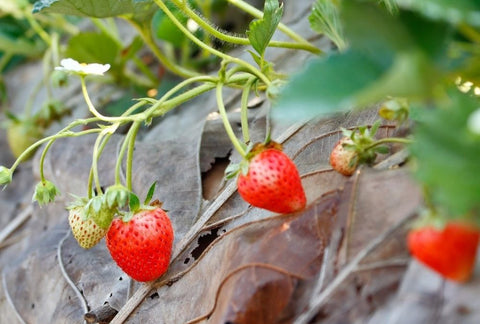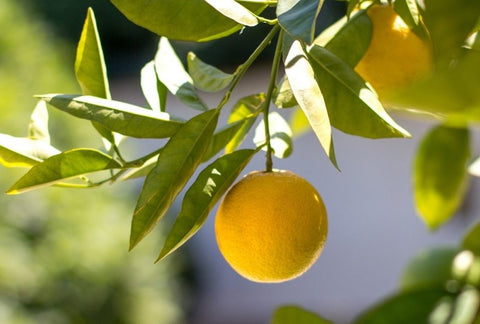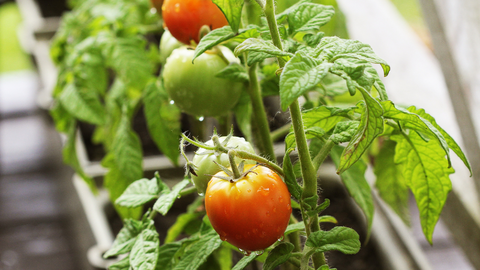Strawberries are the only fruit that wears its seeds on the outside.

Timing
Sprouts in 2-3 weeks. Harvest from Year 1+ on.

Full sun
Equivalent of 6+ hours of direct sun [DLI of 18+ mol/m²/day].

Care
Intermediate. You’ll sprout, thin, prune, and pollinate.
Can You Grow a Strawberry Plant Indoors?
Yes, you can grow a strawberry plant indoors. In fact, it might be easier for some people to manage compared to outdoor gardening.
Best Strawberry Varieties to Grow Indoors
Alpine
Known for their sweet and delicate flavor, these berries are not highly productive but are worth the effort.
Buy on AmazonElan F1
Great for containers and hanging baskets, producing large, sweet fruits with high sugar and vitamin C content.
Buy on AmazonAlbion
This variety has bright red, conical fruits with a firm texture and sweet taste.
Buy on AmazonPortola
This variety produces a large crop of lighter-colored fruits that should be harvested before fully red.
Buy on AmazonGrowing Strawberries Indoors: Best Setup
To start growing strawberry plants indoors, you’ll need:
Planter:
Ceramic Self Watering Planter (preferred) or a pot that is at least 6″ / 1 quart.
Soil:
Standard Potting Mix
Plant Food:
Balanced Blend with equal parts nitrogen, phosphorus, and potassium (NPK 10-10-10)
Grow Light:
A strong grow light providing the equivalent of 6+ hours of direct sun [DLI of 18+ mol/m²/day].
Check out our recommended grow lights for optimal indoor growth.
How to Plant Strawberry Indoors: Preparing Your Planter & Watering Schedule
Strawberry plants thrive in moist soil. Using a Ceramic Self Watering Planter helps maintain consistent soil moisture.
- Fill the planter with dry soil, tamping down the top gently.
- Mix soil in a large bowl with water until moist but not sopping wet (about ½ Cup).
- Mix in Balanced Blend Plant Food.
If using a regular pot, ensure it has drainage holes and let the top soil dry out between waterings.
Starting Your Strawberry: Seed vs. Propagate vs. Nursery Plant
Strawberries can be started from seed, cuttings, or bare-root plants. We recommend starting with bare-root plants for a quicker harvest.
How to Plant Strawberry Seeds
Plant 1 site in a 6″ / 1-quart container, pressing 4 seeds into the surface. Keep soil warm (40-60°F, ideally 60°F). Sprouts appear in 7-30 days.
How to Transplant Strawberry
Prepare your pot by filling it ½ with soil. Trim dead or excessively long roots, shape like a cone, and fit the plant into the soil. Fill up the pot, tamping soil lightly, and water thoroughly.
Where to Grow Your Strawberry Plants Indoors
Strawberries need bright light, equivalent to 6+ hours of direct sunlight. Use a grow light if natural light is insufficient. For more details, see our guide on grow lights.
How Bright Should Your Grow Light Be?
A 24W Sansi bulb placed 6 inches away from the plant provides adequate brightness (PPFD of 500 μmol/m²/s).
How Many Hours of Light?
Strawberry plants need 10 hours of light per day. Use a timer to ensure proper light exposure.
Additional Tips for Indoor Strawberry Growing
Temperature and Chill Requirements
Strawberries need a chilling period (32°F to 45°F for 200-400 hours) during winter. When leaves start to drop in fall, place the plant outside until the chill requirement is met.
Check for Sprouts (Week 2-3)
Seedlings typically appear in 7-20 days. If no sprouts appear in 30 days, the setup might be too cold.
Thin Your Seedlings (Week 4)
Thin to 1 seedling per site to reduce competition. If seedlings are under 1 inch or stretching, they need more light.
Pollinate Your Strawberry Flowers (Year 1+)
Indoors, you may need to manually pollinate flowers. Gently shake or "rub the nose" of each flower to aid pollination.
Harvesting Strawberries (Year 1+)
Harvest when strawberries are bright red. Avoid disturbing less ripe berries in the same bunch.
End of Life (Year 5-6)
Strawberry plants can live 5-6 years but produce runners to propagate new plants, maintaining your strawberry patch indefinitely.
Shop This Blog
These products simplify strawberry growing indoors:
Best Containers for Strawberry: Ceramic Self Watering Planters
Our top pick is the COSWIP planter, with a runner-up being the XS Self Watering Planter by Wet Pot.
Best Soil for Strawberry: Standard Potting Mix
We recommend the Potting Mix by Rosy Soil
Best Nutrients for Strawberry: Balanced Blend
For balanced nutrients, we recommend the Dr. Earth All Purpose Fertilizer.
Best Light for Strawberry: DIY or Soltech
For a high-end option, consider the Aspect Light by Soltech. For a more affordable option, a DIY setup with a 24W Screw-in Bulb by Sansi, a Clamp Light, and a Timer works well. Check out our complete guide on a DIY setup for more information.








How do you fertilize the strawberry plant well after the initial planting? Do you add liquid fertilizer to the water cup below the COSWIP pot? Will that fertilizer get through the ceramic insert? or do you recommend watering the plant from the top with some liquid fertilizer added to the water?